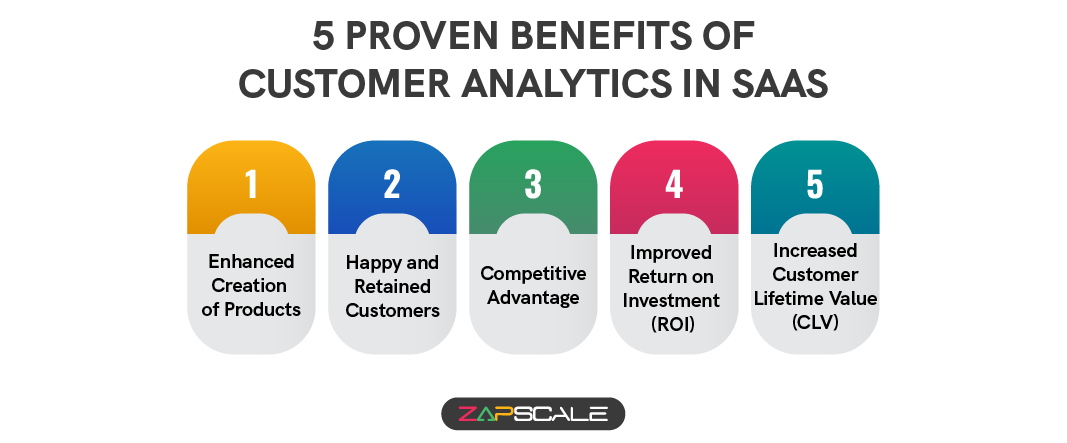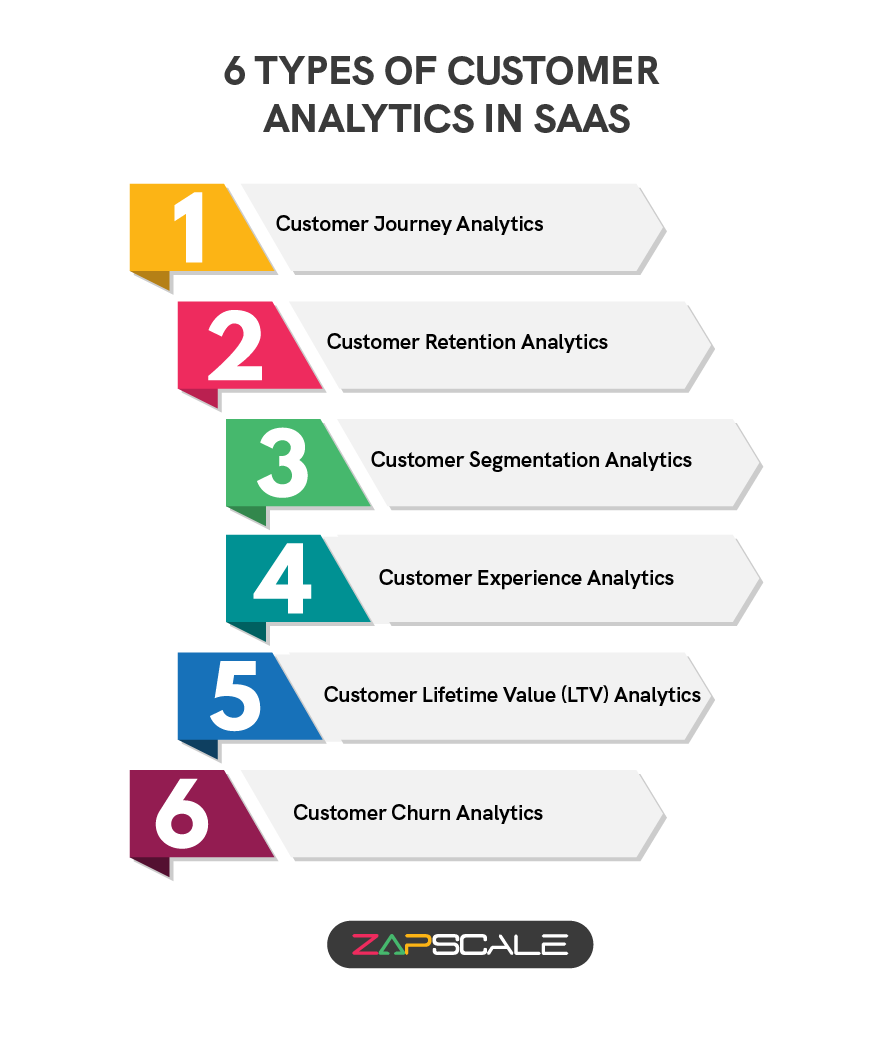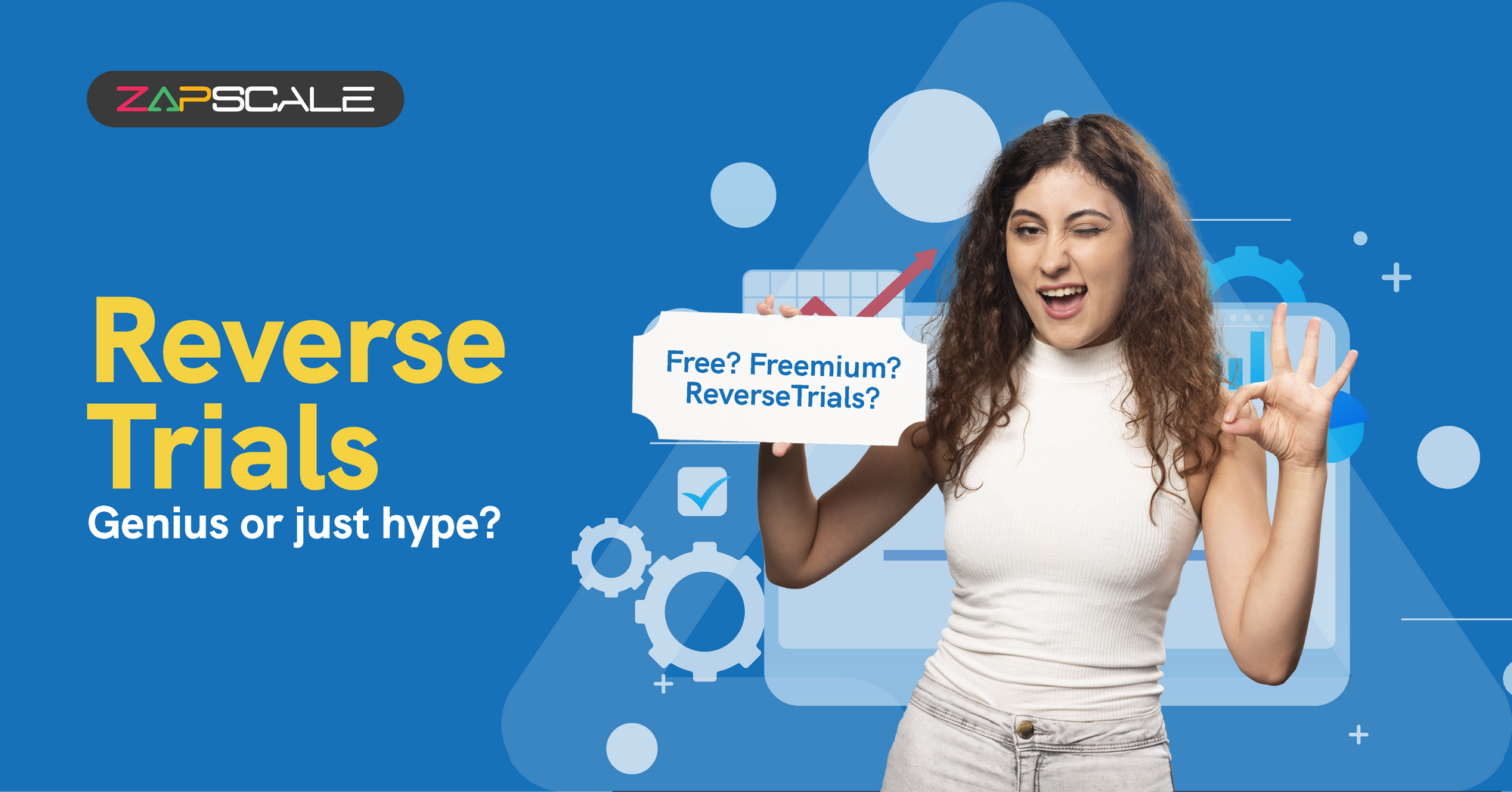CATEGORY > Customer Success Management
Explaining Customer Analytics the SaaS way

Introduction
When it comes to running a business, guesswork doesn’t do the trick.
Businesses require high-quality data to gain insights for making informed decisions, reducing risks, and maximizing opportunities.
Data-driven decision-making becomes possible with customer analytics.
Now, what’s Customer Analytics and why are we talking about it? Let’s find out with further reading.
Customer Analytics - An Overview
Customer Analytics is the process of gathering and analyzing customer data to acquire insights into their behavior, preferences, and trends.
The said technique uses statistical approaches and data mining to help make important company decisions, improve customer experience, and optimize marketing activities.
Companies may improve customer happiness and loyalty by knowing their requirements and behaviors and tailoring their products, services, and marketing methods accordingly.
Now, speaking of ways utilized to obtain customer data, the same can be extracted through a variety of channels, including your product, apps, social media, and feedback surveys. From these sources, team members can examine the data and create a report, either manually or via several customer analytics tools, thus creating an empowered framework across the organization.

As mentioned earlier, integrating customer analytics into corporate strategy is critical for maintaining competitiveness and assuring long-term growth and success for all types of businesses, including SaaS.
The Key Benefits of Customer Analytics
Customer analytics gives us a vivid view of our customer base so that we can serve them better. But are there any other perks we’re likely to be offered after deploying this insightful technique called Customer Analytics?
Let’s get to know them below.
Here are proven benefits of customer analytics that SaaS businesses might enjoy after implementation.

1. Enhanced Creation Of Products
Ultimately, it’s the customers who use your products 24/7 so they are better judges and advocates of them.
By analyzing customer data, SaaS brands can identify and address factors hindering user engagement, such as UI flaws, complex features, slow performance, and technical glitches.
This leads to an improved UX (User Experience) and increased product utilization.
2. Happy And Retained Customers
Customers stay with your brand when they’re heard well. Understanding the preferences of your customers enables more targeted improvements, promoting loyalty and long-term relationships.
Analyzing conversations improves customer service by making it easier to resolve issues quickly. When customers are satisfied with a product, they are more inclined to promote it to others, which helps SaaS brands grow in the long run.
3. Competitive Advantage
We all know how cut-throat the entire SaaS landscape is! That’s when Customer Analytics becomes a necessary component. SaaS businesses that effectively use Customer Analytics get a competitive advantage in the marketplace. How?
It’s because businesses that understand customers better than their competitors may provide superior experiences, create stronger relationships, and differentiate themselves in crowded markets.
With intelligent Customer Analytics, SaaS firms can determine the pricing sensitivity of various customer groups. Businesses may maximize income while remaining competitive in the market by analyzing purchase behavior and competition pricing.
4. Improved Return On Investment (ROI)
As we all know, customer analytics incorporates data to measure marketing, service, and product effectiveness.
This makes it easier for SaaS companies to maximize their investments and increase their ROI by tracking and analyzing KPIs. So, how does the process exactly work?
Well, at first, the data is collected, integrated, and cleaned. Next, the same data is analyzed to obtain insights.
Valuable insights like acquisition cost and customer satisfaction enable SaaS businesses to make sound decisions. With continuous monitoring and adjustment, SaaS leaders can hone their strategies better, thus, increasing their competitiveness and profitability in response to market developments.
5. Increased Customer Lifetime Value (CLV)
Customer Analytics can help SaaS organizations to identify their most lucrative users. By understanding their in-app behavior and preferences, they get to leverage precise upselling and cross-selling opportunities.
Additionally, SaaS brands can deploy customer loyalty analytics to gain useful information regarding how to convert regular users into devoted advocates.
How To Turn Customer Data Into Insights?
Converting customer data into insights is similar to looking through a telescope to see the stars, where each data point illuminates a segment of the customer journey, driving SaaS firms to customer success.
Let’s figure out how to transform customer data into actionable insights:

1. Establish Your Goals
It is essential to have definite goals that are in line with corporate objectives to utilize customer data analysis efficiently.
Whether you wish to boost revenue, trim costs, or enhance customer experience), defining clear objectives will guide your data collection efforts better.
Further, you must set up timelines for data gathering, frequency, and evaluation to make tracking progress a seamless affair.
2. Incorporate The Right Tools
With the power of the right tools, you can develop a no-fuss customer analytics roadmap.
To collect customer information from various touchpoints, use technologies such as CRM systems, website analytics, and surveys.
This merging process offers a bird's eye view to enable informed decision-making for better customer engagement and satisfaction.
3. Follow “Essentials Only’’ Approach
Not everything is important! By creating KPIs that are in line with your business goals, you can concentrate on vital data that can help your organization.
Keep a close eye on key metrics to efficiently track your development. Make use of omnichannel analytics from customer support tools to obtain meaningful qualitative and quantitative data by collecting names, addresses, and feedback. Prioritize transparency by informing customers about the data collection procedure and fostering their confidence in your business's abilities.
4. Update Your Database Regularly
Incorrect data can prove disastrous for your SaaS establishment. Use data validation tools to identify and fix inconsistencies, redundancy, and other types of errors.
To ensure clarity and consistency, standardize data formats by simplifying the information and removing any unnecessary entries. Sort data logically by behavior or demographics for effective analysis. These procedures guarantee well-organized, accurate data for sound decision-making.
5. Ensure Data Privacy
Protect customer information by obeying ethical standards and privacy laws. Get their explicit consent and store data safely via encryption and restricted access.
Use secure passwords and make regular data backups for easy retrieval. Dispose of unnecessary data securely to minimize risks and gain the trust of your customers.
6. Seek Out Trends And Useful Insights
Utilize your precious customer data to enable profitability and scalability for your SaaS business. Filter data and find patterns while combining quantitative and qualitative data to get a complete picture.
Involve your team and use data visualization to effectively guide decision-making for improving functions like marketing, product development, and customer service.

6 Different Types of Customer Analytics in SaaS
When it comes to Customer Analytics, there is more than one type to talk about.
Let’s learn a bit about some of them below.

1. Customer Journey Analytics
Analyzes touchpoints and interactions throughout the customer lifecycle to better understand their behavior and optimize experiences for more customer engagement.
2. Customer Retention Analytics
Focuses on maintaining existing customers by discovering trends and characteristics that influence loyalty, hence, allowing for more tailored customer retention initiatives.
3. Segmentation Analytics
Customers are divided into groups based on shared qualities or behaviors, allowing for more targeted marketing and experiences.
4. Customer Experience Analytics
Evaluates customer interactions and feedback to assess happiness, discover pain points, and improve the entire experience across touchpoints.
5. Customer Lifetime Value (CLTV) Analytics
Estimates the potential revenue that a customer could create during their time with the company, assisting in prioritizing high-value customers and optimizing resources.
6. Customer Churn Analytics
Analyzes the causes and patterns of customer attrition, enabling proactive strategies to reduce customer churn and boost customer retention efforts.

Customer Data Analytics - Top 3 Metrics That Matter
There are key metrics that determine how accurate your Customer Analytics report would be and hence must not be ignored.
Take a look at those metrics below and incorporate them into your Customer Analytics roadmap.
1. Customer Lifetime Value (CLV)
Projects a customer's total expenditure during their entire interaction with your organization, guiding decisions on customer acquisition and retention efforts.
2. Customer Acquisition Cost (CAC)
Identifies the cost of acquiring a new customer - lower customer acquisition cost (CAC) and better customer lifetime value (CLV) signify more growth possibilities for your SaaS company.
3. Customer Retention Rate
Reflects the percentage of customers that continue to do business over time - indicates customer satisfaction and loyalty, crucial for long-term success.
Conclusion
Hence, Customer Analytics is the compass that guides SaaS businesses toward informed decisions and long-term growth, harnessing the power of data to improve customer experiences and remain competitive.
ABOUT THE AUTHOR
Popular from Customer Success Management
Quality Content,
Straight To Your Inbox!
Subscribe for the latest blogs, podcasts, webinars, and events!

Write a Blog
If you have experience in CS and
a flair for writing, we’d love to
feature you.
Write to us on
hello@zapscale.com





